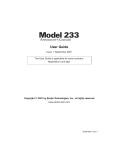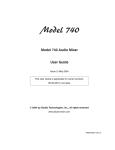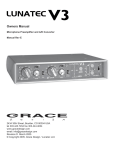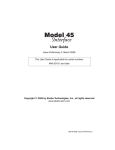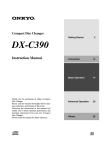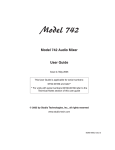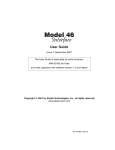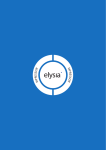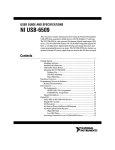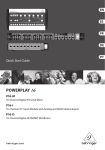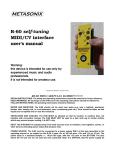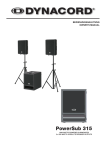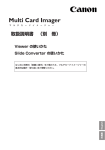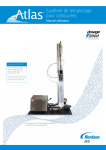Download User Guide - Studio Technologies, Inc.
Transcript
User Guide Issue 4, October 2008 This User Guide is applicable for serial numbers: M210-00415 and later Copyright © 2008 by Studio Technologies, Inc., all rights reserved www.studio-tech.com 50311-1008, Issue 4 This page intentionally not left blank. Table of Contents Introduction ................................................................... 5 System Features ........................................................... 5 Installation and Setup ................................................... 9 Configuration ................................................................ 14 Operation ...................................................................... 21 Technical Notes ............................................................. 25 Specifications ................................................................ 34 Appendix A .................................................................... 35 Block Diagram Model 210 User Guide Studio Technologies, Inc. Issue 4, October 2008 Page 3 This page intentionally not left blank. Issue 4, October 2008 Page 4 Model 210 User Guide Studio Technologies, Inc. Introduction What This User Guide Covers This User Guide is designed to assist you when installing, configuring, and using the Model 210 Announcer’s Console. Additional background technical information is also provided. A product block diagram is included at the end of this guide. System Overview The Model 210 Announcer’s Console is designed to serve as the audio control center for announcers, commentators, and production talent. The tabletop unit is suited for numerous applications including on-air television sports broadcasting. The Model 210 integrates all on-air, talkback, and cue audio signal routing into one compact system. Ease of use, flexible in configuration, and sonically excellent are some of the unit’s highlights. The Model 210 is compatible with most broadcast and audio system environments. Standard connectors are used to interface microphone, headphone, talkback, and IFB signals. Whether it’s microphone switching, talkback output, or headphone cue feed, superior audio quality is maintained throughout. A microprocessor provides the Model 210’s logic power, allowing exacting control of the unit’s operation. A range of configuration choices allow the desired operating configuration to be easily selected. While flexible, the user is presented with an easy-to-use set of controls and indicators. A truly next-generation product, extensive research into the needs and desires of field production personnel was integral to the Model 210’s creation. While primarily targeted for on-air television applications, specialized features are included to allow the Model 210 User Guide Studio Technologies, Inc. Figure 1. Model 210 front panel Figure 2. Model 210 back panel Model 210 to be used in a variety of other audio applications. These include on-air radio broadcasting, stadium announcement, and voice-over/narration booths. System Features Microphone Input A high-performance microphone preamplifier circuit provides low-noise/ low-distortion amplification over a 20 to 60 dB gain range. The gain is adjustable in 10 dB steps. The input is compatible Issue 4, October 2008 Page 5 with balanced dynamic or condenser microphones. The microphone power source is 48 volts nominal and meets the worldwide P48 phantom power standard. An LED indicator serves as an aid for optimizing the setting of the preamplifier’s gain. The output of the microphone preamplifier is used by the main output as well as being routed to the compressor circuit that supports the talkback function. Main and Talkback Outputs The Model 210 provides one main and one talkback output. The main output is designed to serve as the on-air, stadium announcement, or other primary audio feed. Nominally –2 dBu, it is designed as a fully professional interface with high output capability, low distortion, and low noise. It features a high-quality transformer expressly designed for driving long broadcast cable runs. The talkback output is intended to provide production trucks, control rooms, or support personnel with a talent-originated cue signal. The talkback output is transformer-coupled with a +4 dBu nominal signal level. It contains resistors in series with its output connections, allowing the talkback output from multiple units to be directly “summed.” For non-on-air applications, a special Model 210 feature can be enabled, placing the unit in a “production” mode. This allows the main output to be used as a second talkback output. In this configuration the unit can be even more powerful when used in a live event application, such as serving as a master console for a production director. Dynamic Range Control A studio-quality compressor circuit is provided to control the dynamic range Issue 4, October 2008 Page 6 of the signal coming from the microphone preamplifier. Far from a simple “clipper,” the circuit utilizes a sophisticated lasertrimmed voltage-controlled-amplifier (VCA) integrated circuit for quiet, low-distortion level control. The signal from the compressor is always used by the talkback output. In addition, the audio source for the main output can be selected to be either the output of the microphone preamplifier or the output of the compressor. While possibly not appropriate for major on-air situations, having dynamic range control of the main output can offer increased performance for many applications. These could include stadium announcement positions, sports events using nonprofessional on-air talent, and situations where cable crosstalk is of concern. User Controls and Status Indicators Two pushbutton switches, three LED indicators, and two rotary controls provide the user with a clear, easy-to-use interface. One pushbutton switch controls the status of the main output. This is the audio output intended for on-air, announcement, or other primary uses. Two LEDs display the on/off status of the main output. A second pushbutton switch controls the status of the talkback output. This is the audio output used to communicate with producers, directors, spotters, or other behindthe-scenes production personnel. A status LED is associated with the talkback button. Two rotary controls allow the user to adjust the level of the headphone output. Flexibility A large part of the Model 210’s unique power is the ability to configure the operation of the main output and Model 210 User Guide Studio Technologies, Inc. talkback functions. To meet the needs of the many specific broadcast and production applications, a variety of button operating modes is available. The main output button can be selected to operate from among four modes. In the “push-tomute” mode the button performs a momentary mute of the main output. In this way a “cough” button function is created, something typically required for television sports broadcasting. In the “push-to-talk” mode the button provides a momentary active function for the main output. This mode would be appropriate for applications such as stadium announcement. An alternate action “latching” configuration allows the button to enable or disable the main output as desired. This is useful in radio broadcasting, announce-booth, or voice-over applications. The fourth mode provides a hybrid function, supporting both push-to-talk and tap-to-enable/ tap-to-disable operation. This operation is similar to that found in many broadcast intercom system user stations. The button associated with the talkback function can be configured to operate from either of two modes. One of the modes supports a “push-to-talk” function. This is typically used for on-air broadcast applications. The other mode provides a hybrid function, the operation of which is discussed in the previous paragraph. The hybrid mode is especially useful when the Model 210 is used in a production-support application. IFB Input A broadcast-standard “wet” (DC with audio) IFB circuit can be directly connected to the Model 210’s IFB input. Originated by sources such as the RTS™ 4000-series IFB system or IFB interface devices from Model 210 User Guide Studio Technologies, Inc. Studio Technologies, the connected IFB circuit can provide DC power to operate the Model 210 as well as two channels of cue audio. Cue Sources The Model 210 allows the two IFB audio sources to be selected for routing to the headphone output. Originating in production trailers, control rooms, or remote locations, these unbalanced sources normally provide DC power and program-withinterrupt audio on one channel and program-only audio on the other. Each source can be individually assigned to the left channel, right channel, or both left and right. This allows a wide variety of stereo and mono headphone mixes to be created. Some applications may benefit by being able to connect standard line-level audio signals to the Model 210. To meet this need one or two optional line input cards can be installed in the Model 210’s back panel. Each card provides a female XLR-type connector and transformer-isolated +4 dBu nominal input circuit. Each source can be individually assigned to the left channel, right channel, or both left and right. Headphone Output Two rotary controls are provided for user adjustment of the headphone output levels. For application flexibility the actual function of the two “pots” is configurable. For traditional on-air sports applications they can be selected to the dual-channel (“level/level”) mode which provides independent control of the left- and right-channel volume. For use with dual-channel cue signals, or to support user preference, the stereo (“level/balance”) mode can be selected. In this mode one control adjusts the overall level of both the left and right channels, Issue 4, October 2008 Page 7 while the other allows adjustment of the left/right level balance. To help minimize the chance of broadcast cues being missed, both level control modes can be configured so that a minimum headphone output level is maintained. Alternately, the headphone output can be set to fully mute when the controls are at their minimum position. Power Sources Provision has been made to support applications where a monaural cue feed is desired. A configuration switch allows the summing (combining) of the selected left and right headphone sources. In addition to creating a dual-channel mono output it also allows the level controls to be configured as a simple 2-channel mixer. The Model 210 is compatible with IFB circuits provided by most standard broadcast systems. However, maximum performance can often be obtained by using the IFB interface devices available from Studio Technologies. Single-channel and fourchannel units are available, each providing high-quality audio along with an excellent source of DC power. They’re directly compatible with most matrix intercom systems, as well as standard line-level audio signals. Refer to the Studio Technologies website for details. The headphone output was designed to meet the needs of contemporary headphones and headsets. Specifically, the output circuits act as voltage, rather than power, drivers. In this configuration they can provide high output levels with very low distortion and noise, along with minimal current consumption. The output circuits are configured to safely drive stereo or mono loads. This ensures that all types of headphones, headsets, and earpieces can be directly connected. Audio Quality and Protection The Model 210’s circuitry is carefully tailored to provide excellent audio performance. Professional-quality components are featured throughout. For reliability all audio routing is performed using solidstate devices. In all critical audio paths, “clickless” electronic switches provide noise-free control. All audio inputs and outputs make extensive use of protection components. This limits the chance of damage from ESD and other undesirable, yet real-world, hazards. Issue 4, October 2008 Page 8 The Model 210 can derive its operating power from either the IFB input or an external nominal 24 volt DC source. For redundancy, both power sources can be connected simultaneously. An internal switch-mode power supply ensures that all Model 210 features are available when the unit is powered by either source. Configuration Model 210 configurations are made using a number of DIP-type switches. One 8-position switch array is used to set the gain of the microphone preamplifier, the on/off status of phantom power, and the headphone stereo/mono mode. Another 8-position switch array configures which of the IFB audio sources is routed to the headphone output. A third 8-position switch array communicates the desired operating modes to the microprocessor. All switches are accessible via the bottom of the Model 210’s enclosure; the unit does not have to be disassembled. Changes made to any of the configuration parameters become active immediately. To prevent access to the configuration switches a security panel, included with each unit, is attached to the bottom of the enclosure. Model 210 User Guide Studio Technologies, Inc. Connectors The Model 210 uses standard connectors throughout. The microphone and IFB inputs use 3-pin female XLR-type connectors. The main and talkback outputs use 3-pin male XLRs. A ¼-inch 3-conductor jack is used for the headphone output. The external source of 24 volt DC power is connected by way of a 2.1 x 5.5 mm “locking” coaxial power jack. In the world of broadcast and production audio it’s fair to say that applications vary widely. To this end, one or two additional XLR-type connectors can easily be mounted into the Model 210’s back panel. Multiple 3-position “headers” located on the Model 210’s circuit board provide technician-access to all input and output connections. Using a factory-available interface cable kit allows a Model 210 to be optimized to meet the exact needs of specific applications. For example, some applications may prefer to use a multi-pin XLR-type connector to interface with a headset. This can easily be accomplished by adding the appropriate 5-, 6-, or 7-pin XLR-type connector and making a few simple connections. Other applications may benefit from having “mult” or “loop-through” connections, something easily incorporated into a Model 210. One or two optional line input cards, as previously discussed, can also be mounted in the spare XLR positions. 200-Series Announcer Console Products The Model 210 is just one in a series of announcer console products available from Studio Technologies. For applications that require an alternate set of features the other products in the 200-series should be reviewed. Complete information is available on the Studio Technologies website. Model 210 User Guide Studio Technologies, Inc. Installation and Setup In this section interconnections will be made using the input and output connectors located on the Model 210’s back panel. Microphone input, IFB input, main output, and talkback output signals are interfaced by way of 3-pin XLR-type connectors. A ¼-inch 3-conductor phone jack is provided for the headphone output. A 2.1 x 5.5 mm coaxial jack allows connection of an external 24 volt DC power source. System Components Included in the shipping carton are the following: Model 210 Announcer’s Console, user guide, button label sheet, and 24 volt DC power supply. For units shipped to destinations in Japan and North America the power supply will have a nominal AC mains input of 120 volts. For all other destinations a power supply compatible with 220/240 volt AC mains will be included. Microphone Input The Model 210 is compatible with balanced dynamic and condenser microphones. Depending on the application, the microphone may be part of a headset, or be an independent handheld or standmounted model. The Model 210’s 48 volt nominal power source will support essentially all phantom-powered microphones. The quality of the Model 210’s microphone preamplifier and associated circuitry is such that special applications may benefit from using “high-end” microphones. If selected appropriately, models from manufacturers such as AKG, Beyer, Neumann, Sennheiser, and Shure will perform very well in Model 210 applications. Issue 4, October 2008 Page 9 Microphone interconnection is made by way of a 3-pin female XLR-type connector which is located on the Model 210’s back panel. The mating connector (male) should be wired so that pin 2 is signal high (+ or hot), pin 3 is signal low (– or cold), and pin 1 is shield. It’s possible that an unbalanced microphone will also work correctly. In this case, the mating connector (male) should be wired so that pin 2 is signal high (+ or hot), and signal common/shield is connected to both pins 1 and 3. The Model 210 is not compatible with unbalanced “electret”-type microphones that require a source of low-voltage DC for operation. These microphones, sometimes found in low-cost headsets, are not generally suitable for on-air or other demanding applications. As of the writing date of this user guide, the Sennheiser HMD25 headset is very popular for on-air sports broadcasting use. A fine product, it works very well with the Model 210. Note that adding the suffix “-XQ” to the headset’s part number (HMD25-XQ) specifies a 3-pin male XLRtype connector for the dynamic microphone and a ¼-inch 3-conductor plug for the stereo headphones. This configuration is very useful, allowing the headset to work directly “out of the box” with the Model 210. If the writer may digress for a moment to recount a story… an audio dealer once shared a secret with me concerning headsets. He loved selling the “lower-end” (less expensive) models of name-brand headsets, which he did by the veritable “boatload.” Why? Because these usually broke soon after going into service! He knew that on a regular basis he’d receive orders for more of them. Had these Issue 4, October 2008 Page 10 users, from the beginning, purchased only premium-quality headsets, their total cost of ownership would have been much less. Enough said… Headphone Output The Model 210’s headphone output is compatible with stereo or mono headphones, headsets, or earpieces. Connecting devices with a nominal impedance of 100 ohms or greater is preferred. This shouldn’t prove to be an issue as essentially all contemporary devices already meet this condition. Devices are connected to the headphone output by way of a ¼-inch 3-conductor phone jack located on the Model 210’s back panel. As is standard for stereo headphones, the left channel is connected to the “tip” lead of the ¼-inch headphone jack. The right channel is connected to the “ring” lead of the jack. Common for both channels is connected to the “sleeve” lead. Devices with ¼-inch 2-conductor “mono” plugs can also be used with the Model 210’s headphone output. In this arrangement only the tip lead (left channel) will be active. The 2-conductor plug will physically connect (“short”) the ring lead (right channel) to the sleeve lead (common). Technically this won’t damage the circuitry associated with the rightchannel headphone output. (51 ohm protection resistors are electrically in series with the headphone output circuits.) However energy will be wasted if an audio signal coming out of the right channel goes into a “dead short.” There is a simple solution to this issue. No audio source should be assigned to the right-channel headphone output. Refer to the Configuration section of this user guide for details. Model 210 User Guide Studio Technologies, Inc. Main Output Talkback Output The main output is intended to be the “on-air” signal that connects to the input of an audio console. The output is transformer balanced with a nominal signal level of –2 dBu. The actual level will depend on the gain setting of the microphone preamplifier, sensitivity of the microphone, and how loudly the talent speaks into the microphone. The transformer used in the main output is intended for professional broadcast applications. It has a low source impedance and can drive lengthy cable runs with no difficulty. It is capable of driving 600 ohm loads but performs best with loads of 2 k ohms or greater. (This should not prove to be an issue as virtually all contemporary audio equipment has a relatively high input impedance.) As the secondary winding of the output transformer connects directly to the main output connector, care should be taken so that DC voltage is never present on the interconnecting cable. The talkback output is intended for connection to control rooms, production trailers, or other locations where talentoriginated voice cues are required. The talkback output is transformer balanced with a nominal level of +4 dBu. To enhance talkback audio quality, the compressor circuit controls the dynamic range of the signal coming from the microphone preamplifier. The main output is interfaced by means of a 3-pin male XLR-type connector located on the Model 210’s back panel. The interconnecting cable’s mating connector (female) should be wired so that signal high (+ or hot) is on pin 2 and signal low (– or cold) is on pin 3. The cable’s shield can be connected to pin 1, but it will have no function. To limit the chance of grounding interaction between the Model 210 and connected equipment, pin 1 on the main output’s connector is isolated from any point in the Model 210. The fact that pin 1 “floats” will minimize the chance of hums, noises, or buzzes being present on the equipment connected to the main output. Model 210 User Guide Studio Technologies, Inc. For protection against accidental connection to cables that have DC power present, the talkback output is capacitor coupled. In series with the talkback output leads are 300 ohm resistors, making the effective output impedance approximately 600 ohms. These resistors create a passive summing network, allowing talkback outputs on multiple Model 210 units to be connected together. The talkback output is connected by way of a 3-pin male XLR-type connector which is located on the Model 210’s back panel. A mating connector (female) should be prepared so that signal high (+ or hot) is expected on pin 2. Signal low (– or cold) should be expected on pin 3. The cable’s shield can be connected to pin 1. But, like the main output, in order to minimize the chance that ground-interaction problems will arise, pin 1 of the talkback output connector is isolated from the Model 210’s chassis and circuitry. By making pin 1 “float,” an often-feared “ground loop” problem shouldn’t arise. The talkback output is intended to drive lengthy cable runs that are frequently part of a remote broadcast application. While the output circuitry is not intended to be “on-air” quality, overall audio performance should be very good. Devices connected Issue 4, October 2008 Page 11 to the talkback output can range from amplified loudspeakers to analog inputs on intercom systems, and input channels associated with audio consoles. Connecting the talkback output to devices that allow easy control of the signal level can be helpful. For example, connecting to a spare input module on an audio console provides the flexibility to add gain or attenuate as required. A talkbackassociated output connection on the audio console can then connect to the final destination(s). As previously mentioned, the talkback outputs on multiple Model 210 units can be directly connected together. Using a simple “Y” or “W” cable, this passive summing (adding together) of talkback signals allows one audio cable to serve as a master talkback path. A side effect from using this passive summing technique is that signal attenuation will occur. The audio quality won’t suffer, but an audio “pad” is created. If two talkback outputs are connected together, a signal attenuation of 6 dB can be expected. Connecting three talkback outputs together will result in 9.5 dB of attenuation. And four talkback outputs “multed” together will lead to 12 dB of attenuation. In most cases this attenuation won’t pose a problem. Typically a device that receives the talkback signal, such as an amplified loudspeaker, will have an adjustable input sensitivity. IFB Input The Model 210’s IFB input is designed to directly connect with “wet” (DC-biased) IFB circuits. These circuits provide DC power and one or two channels of audio over a standard 3-conductor microphonestyle cable. Typically, the IFB circuit’s interface connector is a 3-pin male Issue 4, October 2008 Page 12 XLR-type wired so that common is on pin 1, DC with channel 1 audio is on pin 2, and channel 2 audio is on pin 3. Some IFB circuits may only have one audio channel. In this case, audio will generally be on pin 3 with pin 2 providing only DC power. The power supplied by an IFB circuit, normally in the range of 28 to 32 volts DC, is usually sufficient to operate the Model 210’s circuitry. The acceptable input range is 24 to 32 volts, with a required current of 105 milliamperes. Note that the specified input voltage is given when measured directly at the Model 210’s IFB input connector, not at the source of the IFB circuit. The one or two audio signals provided by the IFB circuit can serve as the audio sources for the headphone outputs. In North American field and in-studio broadcast applications it is common to find RTS 4000-series IFB equipment being used to provide the IFB circuits. The Model 210 can be directly connected to, and function correctly with, one of these circuits. For reliable operation, especially when using lengthy cable runs, it’s strong-ly recommended that no other device be connected to a 4000-series IFB circuit that is specified for connection to a Model 210. This requirement is due to the current-limited DC source that is supplied by the 4010 IFB Controller. With 4000-series IFB circuits channel 1 (XLR pin 2) provides program audio that is “interrupted” with cue signals. This channel is sometimes referred to as “program-withinterrupt.” It’s important to note that the program audio source fully mutes whenever directors or producers are communicating with on-air talent. Channel 2 (XLR pin 3) of the IFB circuit provides a “program-only” audio feed. It is never interrupted with cue signals. Model 210 User Guide Studio Technologies, Inc. While the Model 210’s IFB input was designed for connection to a “wet” IFB circuit, it’s also possible to connect linelevel audio sources. Please refer to the Technical Notes section of this user guide for details. issues will impact Model 210 operation. Whichever device is providing power, audio signals from the IFB circuit can still serve as the audio sources for the headphone output. External Power Input The two pushbutton switches used in the Model 210 were selected for several reasons. Foremost was the fact that they are highly reliable, using gold-plated contacts for long life in less-than-ideal environments. A second reason was that applying customized labels to the button caps would be very simple. The labels, text printed on clear material, are placed under the clear caps on the top of the buttons. An external source of 24 volt DC power can be connected to the Model 210 by way of a 2.1 x 5.5 mm coaxial power jack which is located on the back panel of the unit. The center pin of the jack is the positive (+) connection. While the requirement for the external source is nominally 24 volts, correct operation will take place over a 20 to 30 volt range. The Model 210 requires 70 milliamperes at 24 volts DC for correct operation. Included with each Model 210 is a 24 volt DC external power supply. The power supply’s DC output cable has been terminated with a Switchcraft® S760K coaxial power plug. This “locking” type of plug correctly mates with the Model 210’s 24 Vdc input jack. The locking feature is important, allowing the external power source to be securely attached to the Model 210. As previously discussed in this user guide, an IFB circuit connected to the IFB input can serve as the Model 210’s power source. Alternately, an external 24 volt DC source can be connected. For redundancy, both the IFB circuit and the external source can be connected at the same time. If one or the other becomes inoperative, the remaining source will provide all Model 210 power. Note that if both an IFB circuit and an external 24 volt DC source are connected, power will be drawn only from the external source. This minimizes the chance that lengthy cable runs or other IFB circuit Model 210 User Guide Studio Technologies, Inc. Pushbutton Labeling From the factory the left button is labeled COUGH and the right button is labeled TALKBACK. This was selected to be appropriate for many on-air applications in English-speaking locations. But it’s expected that these may need to be changed to meet the needs of specific applications. As a “head start” for some applications, a clear sheet with a number of commonly used button designations printed on it is included in the shipping carton. These were created at the factory using a standard personal computer graphics program and laser printed onto 3M CG3300 transparency film. The desired button labels can be cut out with a pair of scissors, following the printed guide lines that indicate the required size. The clear lens on top of each button cap can be removed with a fingernail or small screwdriver. Be certain not to scratch the button if a screwdriver or other small tool is used. The clear label can be removed and replaced. The button cap is then Issue 4, October 2008 Page 13 snapped back into the top of the button housing using finger-pressure only. No tool is required to replace the button cap. If you need to make your own labels the process is quite simple. Use a personal computer to create the desired text. The finished label size should be 0.625-inches (15.8 mm) square. The completed artwork can then be printed on transparency film sheets using a laser or inkjet printer. These sheets are readily available from most office supply stores. A pair of scissors or an X-ACTO® knife will complete the task. label. The security plate is held in place by means of four rubber bumpers (“feet”) that have built-in screws. Using your fingers, remove the four bumpers so that the plate can be removed. Refer to Figure 3 for a detailed view of the configuration switch assemblies. Configuration For the Model 210 to support the needs of specific applications a number of operating parameters must be configured. These include microphone preamplifier gain, phantom power on/off, headphone source selection, headphone stereo/ mono mode, and operating modes. Three 8-position DIP-type switch assemblies are used to establish the desired configuration. These switch assemblies are referred to as SW1, SW2, and SW3, with individual switches designated as SW1-1, SW1-2, etc. The switch assemblies are accessed through openings in the bottom of the Model 210’s enclosure. The enclosure does not have to be disassembled to gain access to the switches. To prevent unauthorized personnel from changing the configuration settings, a security plate is attached to the bottom of the Model 210’s enclosure. For convenience, attached to the security plate is a configuration settings label. It provides a summary of the configurable parameters and related information. Refer to Appendix A for a representative view of the Issue 4, October 2008 Page 14 Figure 3. Bottom view of Model 210 showing configuration switches and compressor active LED Microphone Preamplifier Gain and Phantom Power Five switches are used to set the gain of the microphone preamplifier. One switch is used to select the on/off status of the phantom power supply. Model 210 User Guide Studio Technologies, Inc. Microphone Preamplifier Gain Switches SW1-1 through SW1-5 are used to select the gain of the microphone preamplifier. The choices are 20, 30, 40, 50, and 60 dB. Only one switch should be enabled at a time. There’s no problem changing the gain setting while the unit is operating. Audio clicks or pops might occur during gain transitions, but this shouldn’t be a major issue as long as associated monitor loudspeakers are temporarily attenuated or muted. Unfortunately, there’s no “perfect” gain setting that this guide can recommend. The two issues that impact the setting are output sensitivity of the connected microphone and the acoustical output level of the microphone’s user. With some headset microphones, such as the Sennheiser HMD25, selecting an initial setting of 40 dB is appropriate. Users who speak loudly might need to have the gain reduced to 30 dB. Quiet users might need 50 dB of gain. Selecting the correct amount of gain for an application might take a little experimentation. The goal is to bring the mic’s signal up to line level, nominally –2 dBu for the Model 210’s main output. Operating at this signal level will help to ensure the delivery of “clean” audio to the connected device. The output of the Model 210’s microphone preamplifier is used by the main output and, by way of the compressor circuit, the talkback outputs. So creating a nice “hot” signal will help maintain audio quality, specifically the signal-to-noise ratio, when driving the often-lengthy cable runs. An LED indicator is provided as an aid in correctly setting the gain of the microphone preamplifier. Red in color, this LED is located adjacent to switch assembly 1. It is visible by observing the bottom of the Model 210’s enclosure when the security plate has been removed. Technically, this red LED lights whenever the compressor circuitry is controlling the dynamic range of the signal coming from the microphone preamplifier. The threshold is set to be 2 dB above the Model 210’s nominal internal operating level. So a good “rule of thumb” is to adjust the gain of the microphone preamplifier such that the compressor active LED lights (“flashes”) when the connected microphone is sending signal peaks. During normal operation the LED should not remain fully lit when audio is present on the mic input. It’s important to remember that the compressor active LED is used to assist in setting the gain to the optimal value. It doesn’t necessarily indicate that the main output’s signal is being compressed. Unless specifically configured to perform otherwise, the output of the compressor is only used for the talkback output. Figure 4. Microphone preamplifier gain switch settings Model 210 User Guide Studio Technologies, Inc. It’s expected that the 20 and 60 dB gain settings will not often be used. But there are always exceptions and that’s why Issue 4, October 2008 Page 15 they were included. It’s possible that with a very “hot” microphone, such as a phantom-powered condenser-type, 20 dB of gain could be correct. It’s also possible that a microphone with a very low-level output, such as a ribbon-type, would need 60 dB of gain. But in general, the 30, 40, and 50 dB gain settings will serve most applications. Note that if no gain switch is set to its active (on) position the preamplifier will operate at unity (0 dB) gain. In this mode the preamplifier remains stable, but is intended for use only during factory testing. A valid exception would be where a line-level signal is connected to the microphone input. This could occur with a special Model 210 application. But with a microphone connected as the input source one should never use the 0 dB setting. The issue is that with no gain added to the microphone input signal, the relative noise floor on the main and talkback outputs will be much too high. These outputs are designed for handling line-level signals, expecting to receive the output of the mic preamplifier. In conclusion, the 0 dB gain setting doesn’t highlight a problem, but simply reflects the unit’s gain structure. Phantom Power On/Off The Model 210 can provide 48 volt phantom power to the microphone input. Switch SW1-8 controls whether or not phantom power is active. By phantom power’s very nature it could be left applied to the microphone input at all times. But generally people prefer to turn it off unless required for a specific microphone. Headphone Source Selection Switch assembly SW2 is used to configure the source or sources that are routed to Issue 4, October 2008 Page 16 Figure 5. Phantom power switch settings the stereo headphone output. The headphone sources are IFB channel 1, IFB channel 2, auxiliary input 1, and auxiliary input 2. The IFB channels are provided by way of the IFB input connector located on the Model 210’s back panel. The auxiliary inputs are available only if the optional line input cards have been installed or a special Model 210 configuration has been implemented. Each of the available input sources can be assigned to the headphone output’s left channel, right channel, or both the left and right channels. The Model 210’s circuitry allows any combination of input assignments to be made. For example, consider the situation where a singlechannel IFB system, with both program and interrupt audio on pin 3, is connected to the Model 210. In this case it may be desirable to assign this IFB signal to both the left and right channels. This would entail setting switches SW2-2 and SW2-6 to their on positions. All other switches would remain in their off positions. A more complex application might have a 2-channel IFB circuit connected to the Model 210, with an optional line input card installed and line-level audio from a golf event “spotter” connected to that. In a case such as this, it would be typical for IFB channel 1 to be assigned to the headphone’s left channel, IFB channel 2 assigned to the right channel, and auxiliary input 1 also assigned to the right channel. Model 210 User Guide Studio Technologies, Inc. needs to have a headset’s boom microphone come across the right side of their face, rather than the more-typical left side. In this case it’s important to select the left- and right-channel headphone source assignment accordingly. With the Model 210’s flexible source selection there’s no reason why users, such as on-air talent, shouldn’t have their cue sources assigned correctly. Figure 6. Left and right channel headphone source selection settings This would allow both IFB channel 2 and “spotter” audio to be heard in the headphone’s right-channel output. To achieve this would require that switches SW2-1, SW2-6, and SW2-7 be placed in their on positions. Note that using another Model 210 at the “spotter” location could also prove effective. It would provide all the necessary microphone preamplifier, talkback routing, and headphone monitoring resources. Note that in some cases a user may wish to wear a headset or a pair of headphones in a left/right orientation opposite of what’s usual. In this situation the transducer designated for the left ear would actually supply audio to the user’s right ear, and vice versa. A specific application when this occurs is where on-air talent Model 210 User Guide Studio Technologies, Inc. There may be cases where a monaural “single-muff” headset or headphone will be connected to the Model 210’s headphone output. In this case the desired source(s) should be routed only to the left channel. No sources should be assigned to the right channel. This will eliminate the short-circuit current that could occur when a 2-conductor (monaural) plug is mated with the Model 210’s 3-conductor (stereo) headphone output jack. Headphone Output Mode Switch SW1-6 allows a monaural headphone output to be created. This is accomplished by summing (adding) the selected left- and right-channel cue signals. The combined signals are sent to both the left- and right-channel headphone output driver circuits. The outputs of these circuits connect, by way of 51 ohm series protection resistors, to the headphone output jack. Figure 7. Headphone output mode settings Issue 4, October 2008 Page 17 The headphone output monaural mode feature was specifically included so that a special “2-channel headphone mix” mode can be created. By enabling the mono mode, the two front-panel user level controls (“pots”) can be used to create the desired “mix” of signals being sent to the headphone output. Many applications, especially in production settings, can benefit from this capability. The desired cue sources must be carefully assigned to take advantage of the monaural mode. The first cue source should be assigned, using the DIP-type switches, to the left channel. Its output level will be adjusted by the left control. The second cue source should be assigned to the right channel. Its output level will be adjusted by the right control. There is one limitation related to the headphone mono output mode. It’s the fact that the output will be 2-channel monaural. Whatever signal is present on the headphone output’s left channel will also be present on the right channel. A stereo headphone mix can’t be created. But in most cases this limitation won’t overshadow the benefit of being able to create the mix. For signal-flow clarification please review the block diagram located at the end of this user guide. Operating Modes The eight switches associated with switch assembly SW3 are used to configure the Model 210’s operating modes. Technically, these switches “talk” to the micro-controller integrated circuit and associated software that give the Model 210 its “smarts.” The software has been carefully designed to provide a number of different ways in which the unit can function. It’s critical to carefully review the available options and Issue 4, October 2008 Page 18 choose the ones that best meet the needs of a specific application. Note that switches can be changed even while the Model 210 is powered up and operating. The unit’s operating characteristics will change in “real-time” in response to configuration changes. Main Output Button Mode Switches SW3-1 and SW3-2 configure how the main output button functions. Figure 8. Main output button mode settings There are four available modes: • Push to mute: In this mode the main output is normally active. The main output will mute whenever the button is pressed and held. This is the “cough” mode typically used for on-air sports broadcasting applications. • Push to talk: In this mode the main output is normally muted. The main output will become active whenever the button is pressed and held. • Alternate action: In this mode the main output will change between its active and muted state whenever the button is pressed. Upon power up the main output will be in its muted state. Model 210 User Guide Studio Technologies, Inc. • Hybrid: This mode is a combination of push to talk and alternate action. It’s similar to the way talk buttons function on user stations associated with broadcast and production intercom systems. If the button is pressed and held, the main output will become active until the button is released. If the button is momentarily “tapped” the main output will change state. Upon power up the main output will be in its muted state. Talkback Output Button Mode Switch SW3-3 configures the way the talkback output button functions. Figure 9. Talkback output button mode settings Two modes are available: • Push to talk: In this mode the talkback output is normally muted. The talkback output will become active whenever the button is pressed and held. • Hybrid: This mode is a combination of push to talk and alternate action. If the button is pressed and held, the talkback output will become active until the button is released. If the button is momentarily “tapped” the talkback output will change state. Upon power up the talkback output will be in its muted state. Headphone Output Operating Modes The user is provided with two rotary level controls (“pots”) that are associated with the stereo headphone output. Switches SW3-4, SW3-5, and SW3-6 are used to Model 210 User Guide Studio Technologies, Inc. configuration the way the controls function. With just these three switches a wide range of operating modes can be configured. Carefully reviewing the capabilities of the available functions may prove worthwhile. Dual-Channel or Stereo Mode Switch SW3-4 is used to select whether the controls provide a dual-channel (“level/level”) or stereo (“level/balance”) mode of operation. In the level/level mode the two controls operate independently, each controlling the level of one of the headphone output channels. This mode is generally used for on-air broadcast applications where independent cue signals are provided to the left- and right-headphone channels. In the level/balance mode the left rotary control sets the overall output level for both headphone channels. The right rotary control is used to adjust the balance (the relative levels) of the left and right channels. This mode is generally best suited for applications where a stereo cue source is being provided. Figure 10. Headphone control mode settings Reverse Left/Right Mode Switch SW3-5 is used to select whether the rotary controls are in the normal or reverse left/right mode of operation. When selected to the normal mode, and level/ level mode is also selected, the left control adjusts the level of headphone output’s left channel. (This is the signal that appears on the tip lead of the ¼-inch Issue 4, October 2008 Page 19 Figure 11. Headphone control operation settings 3-conductor jack.) The right control adjusts the level of the right channel. When selected to the normal mode, and the level/balance mode is also selected, turning the balance control in the counterclockwise direction increases the perceived level of the left channel, and vice versa. As you may have already guessed, when selecting the reverse left/right mode of operation everything is reversed! To be more specific, when selected for reverse mode, and the level/level mode is also selected, the left control adjusts the headphone output’s right channel (output jack’s ring lead) while the right control adjusts the left channel. When selected to the reverse mode, and the level/balance is also selected, turning the balance control in the counterclockwise direction increases the perceived level of the right channel, and vice versa. The reverse mode is provided specifically for cases where a headset’s left and right ear pieces are placed on a user’s head in a reverse orientation. This ensures that the user is provided with a consistent and easy-to-use set of headphone level controls. Minimum Level Mode Switch SW3-6 is used to configure the headphone output’s minimum level. In the –40 dB mode the minimum headphone output level is 40 dB below Issue 4, October 2008 Page 20 Figure 12. Headphone output minimum level settings maximum. The headphone output channels will never fully mute. This ensures that any audio signal present on the selected Model 210 inputs will always be present on the headphone output. In most on-air broadcast applications this is the appropriate setting. When the full mute mode is selected, and the level/level mode is also selected, moving either control to its fully counterclockwise position will cause its associated channel to fully mute. When the full mute mode is selected, and the level/balance mode is also selected, turning the level control to its fully counterclockwise position will cause both headphone channels to mute. Turning the balance control to either its fully clockwise or fully counterclockwise position will cause the appropriate channel to mute. Selecting the full mute mode may be appropriate for applications where minimizing the chance of audio “leakage” is important. This could occur when the connected headset or headphones are at times placed on a desk or tabletop. Main Output Source Switch SW3-7 is used to select which audio source is routed to the main output. The choices are the output of the microphone preamplifier or the output of the compressor circuit. For most on-air Model 210 User Guide Studio Technologies, Inc. Figure 13. Main output source settings Figure 14. System mode settings applications the output of the microphone preamplifier is the desired source. This will provide the most natural audio quality with the potential for a large amount of dynamic range. the main output be muted whenever on-air talent uses the talkback output to communicate with production personnel. In some applications it may be desirable for the output of the compressor circuit to be routed to the main output. Appropriate applications could include on-air broadcast situations where nonprofessional talent is present. Controlling the dynamic range of the audio signals on the main output can limit the chance of cable crosstalk and equipment overload. Another typical application where using the output of the compressor would be when the Model 210’s system mode is selected for production. In this case the main output would be used as an additional talkback output and dynamic range control could be beneficial. System Mode Switch SW3-8 is used to configure the overall operating mode of the Model 210. Specifically, it determines how the main output operates vis-à-vis the talkback output. Understanding how the two modes impact overall system operation will ensure that correct operation and maximum usability will occur. When selected to the on-air mode, the main output will mute whenever the talkback output is active. The LED indicators associated with the main output will light accordingly. The onair mode should be selected for all on-air broadcast applications. It’s imperative that Model 210 User Guide Studio Technologies, Inc. When the system mode is set for production, the main output is never muted in response to the talkback output being active. This mode allows the main output to be used, for example, as an additional talkback output. In this way the main and talkback outputs can be used independently, with neither impacting the other. This also allows both buttons to be used simultaneously. When selected for the correct application, the production mode can prove to be very useful. But it’s not appropriate for on-air use! Conclusion Once the switches have been set to the desired configuration, the security plate should be reattached. The four rubber bumpers should be hand-tightened only. No tools should be used. Operation At this point the desired input, output, and power connections should have been made. The button labels may have been revised. Finally, the configuration switches should have been set. Normal operation of the Model 210 can now begin. The unit will begin functioning as soon as a power source is connected. As previously discussed, the power source can be Issue 4, October 2008 Page 21 provided by an IFB circuit, an external 24 volt DC power source, or both. It’s important to highlight the fact that the Model 210 is an active device. Audio signals will not be present on the outputs if correct power has not been supplied. Specifically, the microphone does not passively “cut through” to the main output connector! Upon Model 210 power up, the three status LEDs will light in succession as a firmware “boot up” indication. The unit will then begin normal operation. Depending on the selected configuration, one LED associated with the status of the main output may be lit. The user is now presented with two buttons, three LEDs, and two rotary controls. These are simple to operate and understand, as will be described in the following paragraphs. Pushbutton Switches and Status LEDs Two pushbutton switches are used to control the main and talkback outputs. The way each operates depends on the selected configuration. Three LED indicators are located adjacent to the buttons. They reflect the status of the main and talkback output functions. Main Output Button and LED Indicators The button on the left, factory labeled as COUGH, functions according to the selected configuration. Two LED indicators, located directly above the button, are associated with the status of the main output. The green LED, located on the right, is lit whenever the main output is active. This could be considered as an “on-air” or mic active indicator. At the least it should serve as a “careful what you say” warning! If the Model 210’s system mode is configured to on-air, the red LED, located Issue 4, October 2008 Page 22 on the left, will be lit when the main output is muted. This indicates that it’s safe to speak as one sees fit. If the Model 210’s system mode is configured to production, the red LED will never light. This is to reflect the fact that the main output button has now taken on a function similar to that of the talkback output button. To clarify, when the Model 210 is set to the production mode, the red LED will never light; the green LED will light whenever the main output is active. Main Output Button Modes • Push to mute: If this mode is selected the main output is normally active. The main output will mute whenever the button is pressed and held. • Push to talk: If this mode is selected the main output is normally muted. The main output will become active whenever the button is pressed and held. • Alternate action: If this mode is selected the main output will alternate between its active and muted states whenever the button is pressed. Upon power up the main output will be in its muted state. • Hybrid: This mode is a combination of push to talk and alternate action. It’s similar to the way talk buttons function on user stations associated with broadcast or production intercom systems. If the button is pressed and held, the main output will become active until the button is released. If the button is momentarily “tapped” the main output will change state. Upon Model 210 power up the main output will be in its muted state. Model 210 User Guide Studio Technologies, Inc. Main Output vis-à-vis Talkback Activity This short section applies only in the case where the Model 210’s system mode is configured for on-air and the main output button mode is set to alternate action or hybrid. Talkback activity will always cause the main output to be placed in its off state. If the main output was in the “latched” on state when talkback began, once talkback activity ends that state will resume; the main output will again be in its on (“latched”) state. Talkback Output Button and LED Indicator The button on the right, factory labeled TALKBACK, controls the talkback output. The manner in which the talkback button functions depends on the way it was configured. One LED indicator, green in color, is located directly above the talkback button. It lights whenever the talkback output is active. If the Model 210’s system mode is selected to on-air, whenever the talkback function is active the main output will be placed in the muted state. If the Model 210 is selected to the production mode, the status of the talkback output will not impact the main output. Talkback Output Button Modes • Push to talk: If this mode is selected the talkback output is normally muted. The talkback output will become active whenever the button is pressed and held. • Hybrid: This mode is a combination of push to talk and alternate action. If the button is pressed and held, the talkback output will become active until the button is released. If the button is momentarily “tapped” the talkback output will change state. Upon Model 210 power up the talkback output is will be in its muted state. Model 210 User Guide Studio Technologies, Inc. Headphone Output Level Controls Two rotary controls (“pots”) are located on the Model 210’s front panel and are associated with the headphone output. The way the controls function depends on the selected configuration. One configuration parameter sets the controls to operate in a level/level or a level/balance mode. Another parameter allows the left/right assignment of the controls to be reversed. A third parameter selects whether the headphone output channels will maintain a minimum output level or can be fully muted. Level/Level Mode When set to the level/level mode, the two controls operate independently. Each control sets the output level of one channel of the stereo headphone output. If configured to the normal mode, the control on the left side is used to adjust the level of the headphone output’s left channel. The control on the right is used to adjust the level of the right channel. If configured to the reverse left/right mode, the control on the left side adjusts the headphone output’s right channel. The control on the right adjusts the left channel. When in the level/level mode, and the minimum output level is set for –40 dB, turning each control to its fully counterclockwise position will place its respective output level 40 dB below its maximum. This setting ensures that talent will never be fully “isolated” from potentially important cue signals. If present on the Model 210’s input and assigned to the headphone channels, some audio signal will always be present on the headphone output. If set to the full mute mode, turning each control to its fully counterclockwise position will cause its respective output to fully mute. Issue 4, October 2008 Page 23 Each level control has a mechanical step (detent) that is located at the halfway (50%) position of its rotation range. This is intended to serve as an aid to Model 210 users. In an ideal installation, setting the controls to their detent position will result in a comfortable headphone output level. The user, in response to a changing operating environment, can then move the level controls to get more or less level as desired. The detent position will always remain as a useful reference point. To achieve this condition the audio level on the connected IFB circuit, or auxiliary input, will have to be calibrated as required. This is somewhat counter to the usual mentality of just providing the user with whatever level comes up by default. Spending a few extra minutes “trimming” the audio levels can result in much happier, and more productive, talent. Level/Balance Mode When set to the level/balance mode, the two controls operate together to adjust the desired headphone output level. The control on the left adjusts the overall level of both the left and right channels. The balance control, located on the right, adjusts the relative left/right level balance. In this mode the controls operate in a manner reminiscent of a consumer audio amplifier or receiver. If set to the normal mode, rotating the balance control in the counterclockwise direction reduces the level of the right channel providing the user with more perceived level in the left channel. If set to the reverse mode, rotating the balance control in the counterclockwise direction reduces the level of the left channel providing the user with more perceived level in the right channel. Issue 4, October 2008 Page 24 When in the level/balance mode and the minimum output level is set to –40 dB, turning the level control to its fully counterclockwise position will place both headphone output channels to 40 dB below maximum. This ensures that talent will never be fully “isolated” from potentially important cue signals. In addition, rotating the balance control to either its fully clockwise or fully counterclockwise position will cause the applicable channel to be 40 dB below its maximum. If set to the full mute mode, turning the level control to its fully counterclockwise position will cause both the left and right channels to fully mute. In addition, rotating the balance control to either its fully clockwise or fully counterclockwise position will cause the applicable channel to fully mute. Each control has a mechanical step (detent) that is located at the halfway (50%) position of its rotation range. The balance control will typically be set to its center, detent position, making the level of the left and right channels equal. In an ideal installation, the level control can also be set to its detent position and provide a comfortable headphone output level. This will allow the user, in response to their preference or a changing environment, to adjust the level and balance controls as desired. The detent positions will always remain as a useful reference point. To achieve this condition the audio level on the connected IFB circuit, or auxiliary input, must be adjusted as required. Spending a few extra minutes “trimming” the connected audio levels, rather than just providing whatever happens to come up, should prove worthwhile. The result will be talent that is more relaxed, and an overall production that works more smoothly. Model 210 User Guide Studio Technologies, Inc. Technical Notes Grounding and Shielding As previously discussed in this user guide, the pin 1 connections on both the main and talkback outputs’ 3-pin male XLR-type connectors are “floating,” i.e., not connected to anything within the Model 210’s enclosure. Some audio experts might take offense to this, grousing that this should have been left to the user or installer to be connected or disconnect as desired. However, repeated field testing found that floating pin 1 on the outputs was the key to maintaining quiet audio. From Fenway Park, to the Orange Bowl, and then northwest to Husker Stadium, lifting pin 1 did the trick. A simple solution is available if an application does require that a ground be available on the main and talkback outputs’ interconnecting cables. All Model 210 XLR-type connectors have a ground connection that is made to the interfacing connector’s metal “shell.” And most XLR-type connectors have a pin or connection point available to access its metal shell. By connecting the cable shield to the mating connector’s shell terminal, the common connection typically found on audio interconnections is created. IFB Channel Crosstalk By the very nature of its design, a standard “wet” IFB circuit is prone to exhibit cross-talk between its two audio channels. This occurs because the audio paths are unbalanced (“single-ended”) and typically transported on a single shielded twistedpair audio cable. The primary cause of the crosstalk is the capacitance between the wires in the cable pair. The greater the capacitance, due to cable type and length, Model 210 User Guide Studio Technologies, Inc. the more crosstalk there will be. It’s not surprising to find in sports broadcasting venues that audio from one channel in an IFB circuit can be heard “bleeding” into the other channel. Does this generally create a problem? No, as each channel in an IFB circuit generally carries related audio content. For example, on-air talent hearing in their left ear a small amount of program audio from channel 2 while an interrupt from channel 1 is active, typically wouldn’t perceive this as an issue. There are several ways of reducing IFB channel crosstalk. Probably the easiest way is to use cable pairs that are not twisted. Twisted pairs are great for differential (balanced) signals, but not so great for unbalanced transmission. This is generally because the more twists in a pair the greater the effective cable capacitance. In a stadium or arena setting, choosing standard “telco” pairs may actually work better than “high-performance” audio or data cable! Another option is to use two cable pairs for each IFB circuit. If the pairs are not shielded the wiring is simple. Common would be connected to one side of each pair, and then signal from each channel would connect to the other side of the pairs. If the pairs also contain shields the wiring could be done somewhat differently. One option is to connect common to both cable shields, IFB channel 1 (DC with audio) to one full pair, and IFB channel 2 to the second full pair. A better option might be to have common connect to both shields and one side of the pair that serves IFB channel 2. Other options are available if an application demands low crosstalk. If resources in the broadcast or production facility allow one method would be to run the Issue 4, October 2008 Page 25 IFB circuits “dry” (no DC) and differential (balanced). This would gain the benefits of differential transmission, including minimizing the crosstalk. If optional line input cards have been installed in the Model 210, the balanced line-level signals can be directly connected. However, if it’s desired to connect cue sources to the Model 210 using an IFB-type circuit, the line-level audio signals will need to be “wetted up” into standard IFB circuits. This is easily accomplished using one of several highperformance IFB interface units from Studio Technologies. For further information please refer to the Studio Technologies website. IFB Audio Levels The Model 210 is designed to operate best with IFB audio levels that are nominally –10 dBu. This is the nominal level of most IFB systems, such as the RTS 4000-series. But actually having the correct level present on an IFB circuit is often a “hit-or-miss” proposition. During field testing of prototype announcer’s consoles, Studio Technologies’ personnel found that a wide range of nominal audio levels were present on “real-world” IFB circuits. Many were fine, being reasonably close to the desired –10 dBu. But some were much too low, while others were much too “hot.” We observed one unfortunate baseball “color” commentator being sent interrupt audio signals so “hot” relative to program audio as to almost make his ears bleed! This situation should not have been allowed to happen. In defense of field technical personnel, measuring the audio level of an IFB circuit hasn’t traditionally been an easy proposition. But that situation has now changed. After experiencing this condition in the Issue 4, October 2008 Page 26 “field,” Studio Technologies’ engineers were motivated to design the Model 72 Level Meter/Interface. This compact device plugs directly into IFB and intercom circuits and provides two useful functions: level meters and “dry” audio outputs. Two 5-segment LED meters allow direct observation of the audio signal levels present on IFB or intercom circuits. The display range is optimized for the signal levels found on these circuits, rather than traditional “VU” scaling. The Model 72 also provides two transformer-coupled “dry” audio outputs, one for each IFB or intercom channel. These outputs are useful for a variety of production and testing applications. For example, the outputs can serve as the interface between a traditional “wet” IFB system and a wireless in-ear monitor system. The outputs can also be connected to a monitor panel, allowing visual and aural monitoring of the IFB audio signals. In conclusion, we’re sorry for this shameless promotion of the Model 72 Level Meter/Interface! But necessity was definitely the “mother” when it came to the unit’s invention. Working “in the field” without such a device, we felt “blind” when connecting to IFB circuits. That no longer has to be the case and we think that you’ll find owning one a very worthwhile investment. For further information please refer to the Studio Technologies website. Phantom Power The Model 210 provides a 48 volt nominal source of phantom power to support condenser-type microphones. It’s designed to meet the P48 requirements as specified in the IEC 61938 standard. The circuitry is very simple: two 6.81 k ohm resistors provide a path from a 48 volt source to pins 2 Model 210 User Guide Studio Technologies, Inc. and 3 of the microphone input connector. The resistors and the power source work together to provide 48 ±4 volts, up to a maximum current of 10 milliamperes. Symptoms of Insufficient Power A core part of the Model 210’s internal circuitry is a switch-mode power supply that produces +48 volts, +12 volts, +5 volts, and –12 volts. This power supply circuit works very well as long as it is “fed” with sufficient input voltage and current. “Sufficient” is defined as a minimum of 24 volts on the IFB input and 20 volts on the external 24 volt DC input. The necessary current, 105 milliamperes for the IFB input and 70 milliamperes for the external input, must be supplied over their respective voltage ranges. It’s worth discussing what will happen if either power source falls below its specified minimum. Typically, if the Model 210 is being powered by an external 24 volt nominal power source, normal operation will continue until the input falls to the 18-20 volt range. As the input voltage drops below this range the Model 210’s internal power supply will have reduced stability, operating in this manner until its low-voltage shutdown circuit halts operation. Note that as the input voltage moves down from 24 volts the input current will rise proportionately to make up for the loss of power. If an IFB circuit is powering the Model 210, maintaining the required voltage and current is more critical. Should the voltage or current fall below the specified minimum, the Model 210’s power supply circuit will again become unstable. This will become an issue as noise will be induced into Model 210 User Guide Studio Technologies, Inc. the IFB circuit’s audio signals. The reason is simple: an IFB circuit “multiplexes” 3-conductors so that they carry both power and audio signals. If sufficient amounts of voltage and current are supplied to the Model 210’s IFB input, the Model 210’s power supply will draw a steady amount of energy. This will not disturb the analog signals on pin 1 (common for DC and audio) and pin 2 (DC and channel 1 audio). But if the Model 210’s power supply is not supplied with sufficient energy (volts x amps) it will try to draw what it needs from the IFB circuit, becoming unstable in the process. The IFB circuit’s audio signals will be corrupted by the power supply’s attempt to draw enough power. Instead of nice clean audio there will be squeaks, squeals, and some awfully funky noises added. Again, in a low-voltage or lowcurrent situation, no damage will be done to the Model 210’s circuitry but correct operation will not be possible. In most cases maintaining the IFB circuit’s required voltage and current shouldn’t be a problem. But issues may arise due to malfunctioning IFB circuit sources or poor interconnect cabling. Typically, excessive cable length won’t be the cause of problem. Generally, problems will be caused by broken or damaged connector pins, dirty patch points, or damaged (partially open) cable conductors. Measuring the IFB circuit’s voltage and current draw directly at the Model 210’s IFB input connector will quickly identify if there’s a power issue. And now for another shameless “plug” for other Studio Technologies products: Frankly, most devices that supply IFB circuits for broadcast applications use outdated technology that provides mediocre performance. That’s why Issue 4, October 2008 Page 27 Studio Technologies’ developed highperformance IFB interface units. These products do an excellent job of providing power and audio to connected devices such as the Model 210. However, unlike other products, the power supplied by these units’ IFB circuits maintain their output voltage all the way to their full rated current. The result is being able to power more devices over longer cable runs. In addition, the audio quality of these units is superior. For further information please refer to the Studio Technologies website. LED Colors As previously described, two LED indicators are associated with the main output and are located directly above the main output pushbutton switch. The red LED, located on the left, is lit whenever the main output is muted. The green LED, located on the right, is lit whenever the main output is active. The thought process behind the color choices was that red would relate to the main output being muted (“stop”) while green would relate to the main output being active (“go”). It’s possible that these color choices may not meet the needs of all users and applications. For example, it’s reported that one European broadcaster typically uses these two colors in the opposite fashion. Their choice is to have the red LED lit whenever the main output is active, warning the talent that they are “on-air.” The green LED is lit whenever the main output is muted, indicating to the talent that it’s “safe” to say whatever they wish, about whomever they wish to say it about! For consistency, the LED associated with the talkback button was selected to be green. This lights whenever talkback is active. It’s possible that some applications Issue 4, October 2008 Page 28 may benefit from revising this LED color too. While red is certainly one possible choice, other colors are also a possibility including amber, orange, or blue—these days there are lots of choices available. The only limitation is the amount of current available to light each LED. Using series resistors of no less than 560 ohms will ensure correct Model 210 operation. A qualified technician can easily revise the LED colors to meet an application’s exact needs. The process would begin by disassembling the Model 210’s enclosure and detaching the pushbutton/LED printed circuit board assembly. The LEDs would then be unsoldered, removed, and reinstalled (or replaced) in the desired locations. To control the LED current and set the brightness, a resistor is electrically in series with each LED. An 820 ohm, ¼-watt resistor is associated with the red LED while a 560 ohm, ¼-watt resistor is associated with each green LED. These resistors would also have to be unsoldered, removed, and reinstalled. Then the unit would be reassembled and tested to confirm that the changes function as desired. For additional information about changing the LED colors, please contact Studio Technologies’ technical support. Travel Case For portable applications it may be desirable to store and transport each Model 210 in a protective case. After much travel with prototype announcer console units, Studio Technologies’ personnel learned to appreciate the Pelican Model 1450 case. Purchased with the foam interior option, it does an excellent job of holding one Model 210, its associated 24 volt DC power supply, and documentation. Some Model 210 User Guide Studio Technologies, Inc. applications may benefit from selecting a larger case that would also hold a related headset, cables, etc. A larger case could also be selected that would hold multiple Model 210 units. Pelican sells their products through a dealer network, many of which can be located via a web search. Connecting Line-Level Inputs The Model 210 is designed to directly connect with “wet” broadcast IFB circuits. However, there may be applications where it would be helpful to also be able to connect standard line-level audio sources. If it’s anticipated that line-level audio sources will frequently need to be connected to the Model 210, one or two line input cards can be installed. These cards, available from Studio Technologies and purchased separately (part number 31084), are mounted into the spare connector locations that are provided on the Model 210’s back panel. Each line input card contains passive circuitry, including a 3-pin female XLR-type connector and a 10 k ohm to 10 k ohm isolation transformer. Once installed, balanced or unbalanced line-level audio sources can be directly connected. Note that in cases where only line-level signals are connected an external source of 24 volt DC power is required. This shouldn’t pose a problem as a 24 volt DC power supply is included with each Model 210. Each line input card kit contains a printed circuit board assembly, an interconnecting cable, and hardware. To install the kit is very simple. The XLR-type connector is mounted into one of the spare connector locations on the Model 210’s back panel. This secures the connector and associated printed circuit board to the enclosure. The interconnecting cable is then Model 210 User Guide Studio Technologies, Inc. used to link the card and the Model 210’s main printed circuit board assembly. One end of the cable is plugged into the line input card’s 3-position “header” that is labeled OUT. The other end of the cable is plugged into the desired 3-position header located on the main printed circuit board. The header associated with auxiliary input 1 is labeled P11. The header associated with auxiliary input 2 is labeled P10. Note that the unused header remaining on the line input card has its pins “multed” with the leads on the 3-pin female XLRtype connector. It is provided for other applications that may need it. Additional installation details are provided in the next section of the user guide. Included is a recommended connector labeling method that is appropriate when line input cards are installed. For balanced audio sources the mating connector (3-pin male XLR-type) should be wired so that signal high (+ or hot) is connected to pin 2, signal low (– or cold) is connected to pin 3, and shield is connected to pin 1. Unbalanced sources should be wired so that signal high is on pin 2, and signal low/shield is connected to both pins 1 and 3. If this results in hum on the input, try connecting signal high to pin 2, signal low/shield to pin 3, and pin 1 left unterminated (“floating”). Several things are worth mentioning when it comes time to actually using a line input card. The input is transformer coupled with a nominal input impedance of 10 k ohms. Capacitors in series with the transformer’s primary provide protection again accidental connection of a cable that has DC voltage present on it. The nominal input level is +4 dBu but should work correctly with signal levels down to nominal Issue 4, October 2008 Page 29 –10 dBu. So that the rotary level controls provide a more comfortable range of operation during actual use, reducing the level of a “hot” input signal by 3 to 6 dB is preferred, versus having a full +4 dBu nominal level. Note that if one or two line input cards are installed in a Model 210, both “dry” linelevel audio signals and a “wet” IFB circuit can be connected at the same time. The audio sources will be routed to the headphone outputs by way of the headphone source configuration switches. Each of the four possible audio sources can be routed to the left-headphone output, the right-headphone output, or both headphone-output channels. Details on how to use these switches are provided in the Configuration section of this user guide. In “emergency” situations it’s possible to connect line-level audio signals directly to the Model 210’s IFB input connector. This can be successfully done as long as several limitations are taken into account. The first limitation is that the 10 k ohm input circuit presents an unbalanced load to the source. In most cases this shouldn’t pose a problem. If a balanced interconnection scheme must be maintained, an in-line isolation transformer can be used. A second limitation is that the audio level presented must not exceed 0 dBu or signal “clipping” may occur. Prepare a 3-pin male XLR-type connector so that the line-level audio source designated as IFB channel 1 is connected with signal high on pin 2 and low/shield on pin 1. The audio source designated as IFB channel 2 should be connected with signal high on pin 3 and low/shield on pin 1. With this connection scheme the nominal input level is –10 dBu, the same as with an IFB circuit. This may require that an Issue 4, October 2008 Page 30 external attenuator (“pad”) be used to reduce the level of the connected signal. As expected, powering the Model 210 requires an external source of 24 volt DC to be connected. Additional Connectors Two spare connector locations are provided on the Model 210’s back panel. From the factory they contain blank plates that can be readily removed and replaced with a variety of XLR-type connectors. These spare connector locations are specifically included so that a Model 210 can be customized to meet the many specific needs that arise in broadcast and related audio applications. Expected uses for these locations include adding a 5-, 6-, or 7-pin XLR-type connector to allow direct connection of a broadcast headset. Other uses include creating a “loop through” or “mult” functions for the talkback output or IFB input connections. In addition, Studio Technologies offers an optional line input card that mounts directly in a spare connector location. This was previously described in this user guide. The spare connector locations are compatible with the Neutrik DL-series of connectors. For flexibility, versions are available that provide from three to seven contacts. For example, a compatible 3-pin female connector would be Neutrik part number NC3FD-L-1. To support headsets the NC6FDS-L-1 is often used. This is a 6-pin female connector with the unique Switch-craft 6-pin arrangement. The hardware that secures the blank plates to the Model 210’s back panel is also intended to secure the replacement connectors. If connectors are added to the Model 210’s spare connector locations adding labels to those connectors can be helpful. Model 210 User Guide Studio Technologies, Inc. For a great look it is recommended that Brother® P-Touch ¼-inch (6 mm) labels be created. Tape material that prints white text on a black background works out well for the Model 210. The Brother label cassette number TX-3151, white on black, is appropriate for use with many of their printers. In addition to the spare connector locations on the back panel, provision has been made to allow easy interconnection with the Model 210’s printed-circuit-boardmounted input and output connectors. This was accomplished by including numerous 3-position male “header” connectors on the Model 210’s circuit board. These headers, on 0.1-inch centers, are wired in parallel with the Model 210’s connectors. This “no solder” solution makes customizing a Model 210 a simple process. The headers, located on the Model 210’s printed circuit board, are Molex® part number 22-23-2031. They mate with Molex housing number 22-01-3037. To make the interconnection, separate crimp terminals are attached to loose wires and then “snapped” into the housing. Molex part number 08-50-0114 specifies crimp terminals that are appropriate for wires of 22 to 30 gauge. These parts are available worldwide from sources such as Digi-Key (www.digikey.com). To make the process of connecting to the Model 210’s headers a simple task an interface cable kit, part number 31087, is available from Studio Technologies. Each kit includes five cable assemblies and a length of heat-shrinkable tubing. Each cable assembly consists of a mating connector with three color-coded wires attached. These wires, nominally 12 inches in length, allow convenient soldering to a connector slated to be installed Model 210 User Guide Studio Technologies, Inc. in a spare location on the Model 210’s back panel. For reference, the wire color for pin 1 is gray, pin 2 is yellow, and pin 3 is blue. The heat-shrinkable tubing is provided so that the connector solder cups can be insulated from each other. It will also provide some strain relief to the solder joints. Be certain to slip the desired length of tubing over the wire prior to soldering a connection! (If the writer had a dollar for every time he forgot to put tubing on a wire (or slip on a connector shell) before making a solder connection…) The Model 210’s enclosure must be disassembled prior to installing connectors in the spare locations. Four hex-head machine screws, two on the bottom front of the enclosure and two on the back panel, must be removed. A 5/64-inch hex driver is required. The cover can then be carefully separated from the chassis, remaining attached by means of a flexible cable assembly. This “flex-cable” assembly links the main printed circuit board assembly with the board assembly that contains the pushbuttons and LED indicators. Ensure that the flex cable is not damaged while the Model 210 is being customized. For easier access, the pushbutton/LED board assembly can also be easily removed. The 3-position headers on the Model 210’s main circuit board assembly are located close to their related input or output connectors. The following list provides the printed circuit board reference numbers and associated functions: P3: Headphone output, pin 1 common, pin 2 tip (left), pin 3 ring (right). P4: Microphone input, pin 1 shield, pin 2 high, pin 3 low. Follows back-panel 3-pin female XLR pin assignment. Issue 4, October 2008 Page 31 P5: Main output, pin 1 shield, pin 2 high, pin 3 low. Careful! Back-panel 3-pin male XLR has pin 1 floating, pin 2 high, pin 3 low. P6: Talkback output, pin 1 shield, pin 2 high, pin 3 low. Careful! Back-panel 3-pin male XLR has pin 1 floating, pin 2 high, pin 3 low. P7: IFB input, pin 1 common, pin 2 DC with channel 1 audio, pin 3 channel 2 audio. Follows back-panel 3-pin female XLR pin assignment. P9: External 24 volt DC input, pin 1 common, pin 2 +24 volts, pin 3 not used. Backpanel 2.1 x 5.5 mm jack has +24 volts on center pin. Header P8 is used by the backpanel 24 Vdc jack assembly and is electrically in parallel with P9. Additional functions can be accessed using these 3-position headers: P10: Auxiliary input 2, pin 1 common, pin 2 unbalanced audio, –10 dBu nominal. P11: Auxiliary input 1, pin 1 common, pin 2 unbalanced audio, –10 dBu nominal. P12: Pushbutton backlighting, pin 1 common, pin 2 button lamps, pin 3 current limited 24 volts from external 24 volt DC input. P14: Remote switch connections, pin 1 common, pin 2 main output control, pin 3 talkback output audio. Pushbutton Backlighting For special applications, provision has been made to allow illumination (“backlighting”) of the two pushbutton switches. This may prove useful for applications where adequate room lighting is not available. It can also serve in custom Model 210 configurations. Note that this is an advanced feature, intended only to be implemented by a qualified technician. Issue 4, October 2008 Page 32 From the outset several limitations must be discussed. The first is that button backlighting is not intended to serve tally applications. (A common connection to power both lamps is provided; independent access to the lamp connections on each button is not provided.) It is strictly intended to provide a moderate amount of illumination to the button’s clear lens and associated labeling. The second restriction is that power for the backlighting function cannot be provided by the IFB input—there is simply not enough current available from a typical IFB circuit to power the Model 210 and light the lamps. However, power from the external 24 volt DC source can be used. This requires that this power source be connected whenever backlighting is desired. From the factory, lamps (“bulbs”) are not installed in the pushbutton housings. They are pluggable T-1 bi-pin type and are simple to install. The mating socket is accessed by removing the button’s lens caps, graphic label, and back frosted lens. Compatible incandescent lamps with a nominal rating of 18 volts, 28 mA are available from Studio Technologies (part number 12030). Bulbs with other nominal voltages should also be available from electronics parts vendors. While compatible LED-based lamps are probably also available, incandescent lamps, when powered below their rated current and voltage, can provide extremely long and reliable operation. A 3-position header connector, labeled P12, is located on the Model 210’s main printed circuit board. It provides access to, and a means to power, the two lamps. Pin 1 of the header is connected to the common point of the Model 210’s circuitry, which is also connected to one contact Model 210 User Guide Studio Technologies, Inc. on both lamps. Pin 2 of the header is connected to the other contact on both lamps. Pin 3 is connected, by means of a current limiting resistor, to the external 24 volt DC source. If lamps were obtained from Studio Technologies then adding a “jumper” from pin 2 to pin 3 is all that is required to get things going. A standard 0.1-inchcenter jumper, commonly used on electronic equipment, is all that is required. A 390 ohm, 1 watt resistor is electronically in series between the external 24 volt DC input and pin 3 of the header. When used with the lamps available from Studio Technologies, the resistor limits the lamp current to approximately 40 mA. This lights the lamps to a moderate intensity. If a different type of lamp is installed, its power source should be connected to pins 1 (common) and 2 (lamps) of the header. Remote Control Connections Provision has been made on the Model 210’s printed circuit board assembly to allow external switches or contact closures to control the main output and talkback output functions. A 3-position header, labeled P14, provides access to the circuitry associated with the functions. Pin 1 of the header is connected to the common point of the Model 210’s circuitry. Pin 2 of the header is connected to the circuitry associated with main output pushbutton. Pin 3 of the header is connected to the circuitry associated with the talkback output pushbutton. The input circuitry is “active low,” with a 10 k ohm resistor connected to +5 volts acting as a pull up. A combination of resistors and capacitors provide ESD protection. A qualified technician can use these inputs for special applications. Contact the factory for additional details. Model 210 User Guide Studio Technologies, Inc. Compressor Circuit In this section some general information about the Model 210’s compressor circuit will be provided. As previously discussed, the output of the microphone preamplifier circuit is connected to a studio-quality compressor circuit. The output of the compressor is used by the talkback output and, if configured, the main output. (In most cases the main output will utilize the signal coming directly out of the microphone preamplifier.) The gain element in the compressor circuit is a laser-trimmed voltage-controlledamplifier integrated circuit. It provides accurate, low-noise, low-distortion performance. The threshold of the compressor circuit is 2 dB above the Model 210’s nominal internal operating level of –2 dBu. A 5:1 compression ratio is implemented and, like the threshold level, is not field adjustable. The threshold and ratio settings were selected so that excellent talkback audio would be provided. By controlling the dynamic range, intelligibility can be improved and overloading of connected devices can be avoided. An LED indicator lights whenever the compressor’s threshold has been reached and the circuit is actively controlling the dynamic range. This LED is provided as an aid when setting the gain of the microphone preamplifier. Issue 4, October 2008 Page 33 Specifications Main Output: General Audio: Nominal Level: –2 dBu Frequency Response: 20 Hz-20 kHZ, ±0.1 dB, mic in/main out Maximum Level: +20 dBu into 2 k ohms Distortion (THD+N): 0.008%, measured at 1 kHz, mic in/main out Talkback Output: S/N Ratio: 80 dB, referenced to –46 dBu mic in/ –2 dBu main out Type: transformer-coupled with series capacitors and isolation resistors Connectors: Mic In, IFB In: 3-pin female XLR-type Main Out, Talkback Out: 3-pin male XLR-type Headphone Out: ¼-inch 3-conductor phone jack 24 Vdc Power In: coaxial power jack, 2.1 x 5.5 mm, locking bushing, compatible with Switchcraft S760K plug Type: balanced, transformer-coupled Impedance: 100 ohms, nominal Impedance: 600 ohms, nominal Nominal Level: +4 dBu Maximum Level: +11 dBu (compressor restricts maximum) Headphone Output: 1, stereo Compatibility: intended for connection to mono or stereo headphones or headsets with nominal impedance of 100 ohms or greater Spare Connector Locations: 2 Type: voltage driver Allows one or two Neutrik NC*D-L-1 connectors to be installed (*=3F, 3M, 5F, 5M, 6F, 6FS, etc.) Maximum Output Voltage: 8 Vpp, 150 ohm load Microphone Input/Preamplifier: Type: electronically balanced Input Impedance: 2 k ohms, nominal Gain Range: 20 to 60 dB, nominal, adjustable in 10 dB steps Compatibility: dynamic or phantom-powered mics Phantom Power: 48 Vdc, nominal, meets IEC 61938 IFB Input: Type: 2-channel, unbalanced (pin 1 common; pin 2 DC with channel 1 audio; pin 3 channel 2 audio). Also compatible with “dry” audio signals with signal levels of less than 0 dBu. Power Sources: IFB: 24-32 Vdc, 105 mA External: 24 Vdc nominal, 70 mA @ 24 Vdc; acceptable range 20-30 Vdc. Units shipped to North America and Japan include a 120 V input/ 24 Vdc output power supply. Units shipped to all other locations include a universal input/24 Vdc output power supply. Options: one or two line input cards can be installed to provide support for connection of linelevel balanced or unbalanced audio sources Dimensions (Overall): Nominal Level: –10 dBu 5.6 inches wide (14.2 cm) 3.3 inches high (8.4 cm) 8.5 inches deep (22.4 cm) Optional Line Inputs: 2 Weight: 3.4 pounds (1.6 kg) Impedance: 10 k ohms, nominal Type: balanced, transformer-coupled Impedance: 10 k ohms, nominal Nominal Level: +4 dBu Specifications and information contained in this User Guide subject to change without notice. Compressor: Threshold: 2 dB above nominal level Attack/Release Time: 2 mSec/100 mSec, nominal Slope: 5:1, nominal Status LED: compressor active Issue 4, October 2008 Page 34 Model 210 User Guide Studio Technologies, Inc. Appendix A A label is attached to the security plate on the bottom of the unit. It provides a summary of the configurable parameters and related information. The actual label size 4.25 inches by 4.60 inches. Model 210 User Guide Studio Technologies, Inc. Issue 4, October 2008 Page 35 This page intentionally not left blank. Issue 4, October 2008 Page 36 Model 210 User Guide Studio Technologies, Inc.





































